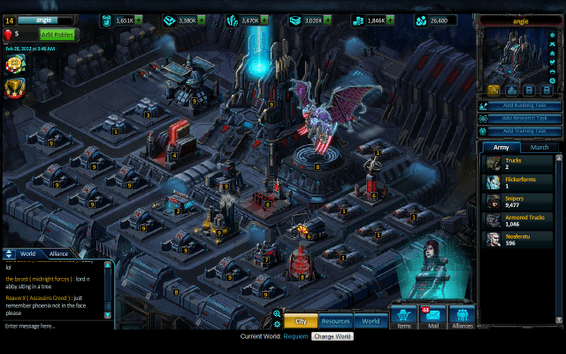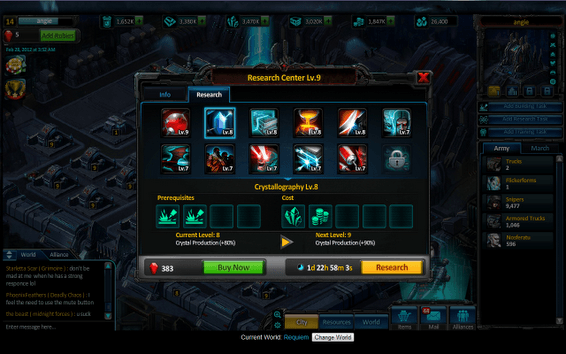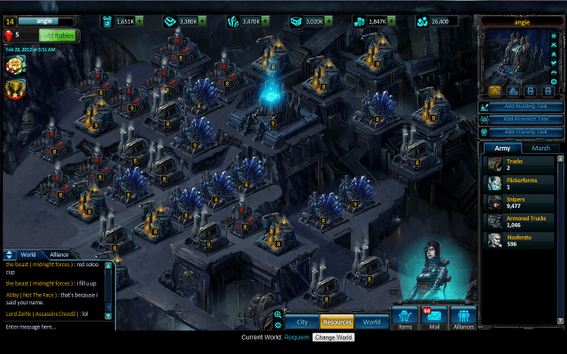- Wondering how to get Monopoly GO! free rolls? Well, you’ve come to the right place. In this guide, we provide you with a bunch of tips and tricks to get some free rolls for the hit new mobile game. We’ll …
Best Roblox Horror Games to Play Right Now – Updated Weekly
By Adele Wilson
Our Best Roblox Horror Games guide features the scariest and most creative experiences to play right now on the platform!The BEST Roblox Games of The Week – Games You Need To Play!
By Sho Roberts
Our feature shares our pick for the Best Roblox Games of the week! With our feature, we guarantee you'll find something new to play!All Grades in Type Soul – Each Race Explained
By Adele Wilson
Our All Grades in Type Soul guide lists every grade in the game for all races, including how to increase your grade quickly!
Thirst of Night Review
If you watched the Blade Trilogy and found yourself rooting for the vampires, I will never forgive you for betraying Wesley Snipes. But also, there is a game on Google+ waiting for you. Thirst of Night asks “what would happen if bloodsuckers took over the world?” and provides the answer with a strategy game that puts you in charge of a vampiric kingdom. But does the game have the lifeblood to survive, or does it just suck?

Vampires have taken over the earth. Luckily, you’re one of them.
If you watched the Blade Trilogy and found yourself rooting for the vampires, I will never forgive you for betraying Wesley Snipes. But also, there is a game on Google+ waiting for you. Thirst of Night asks “what would happen if bloodsuckers took over the world?” and provides the answer with a strategy game that puts you in charge of a vampiric kingdom. But does the game have the lifeblood to survive, or does it just suck?
For centuries, vampires have been oppressed by the human population that so selfishly hogged the day time as their own and attempted to keep the fanged that craved freedom locked away. But after a sizable electromagnetic pulse shook the earth and set off rounds of volcanic eruptions around the world, the human stranglehold on earth dissipated in the clouds of ash that blocked out the sun, creating a never-ending state of twilight (no, not the book). I’m not great with science, so I assume this story checks out. This lays the groundwork for the world that developer Kabam drops you into in Thirst of Night.

To start the game you’ll pick a general from a list of unlocked characters that will serve as your all-purpose advisor who will float around in the bottom on your screen. It doesn’t matter who you pick or what you name them (I love vampires with oddly generic human names. It’s kind of like a cat with the name “George”– always funny), as they are essentially an NPC that only you see.
Once you’re into the game, you’ll be presented with a small city that you’ll be expected to build up and protect. You’ll work on increasing the size, productivity and functionality of the city through quests that will encourage building new units, performing upgrades, and will in turn reward you with items and resources.
The first quests you’ll be presented will walk you through the essentials of gameplay. It’s a pretty ingenious set up that gets you up to speed and lands you some nice benefits without ever making it feel like the game is totally holding your hand. While your general will talk you through some aspects of the game, it’s never too forceful or linear that you’ll feel pushed into too many decisions. This allows the freedom of building your own strategy along with your city.
You’ll want to create that gameplan fairly quickly, because you’ve got seven days of freedom to build, upgrade, and plot without any worry of intervention from the outside. Once your grace period ends, prepare yourself to entire into the world and try to rule the day–err, night. Whatever, you’re going to rule. Use your attack-free time to build houses and increase population, create an army and collect platinum–the new currency of the world–to give yourself the best chance to survive.

Honestly though, that “struggling to survive” thing is a little better in theory. There’s a lot of dead space in Thirst of Night. There are plenty of players that start the game and do little more, or have been away from the keyboard for an extended period of time and have left their city open for plundering. Assuming you plan to play this game regularly, don’t expect for too many challenges to come your way. That said, when they do you’ll want to be prepared because the people that are still playing are powerhouses.
There are plenty of units to build and upgrade, and being a skilled micromanager will be key to success. There are your standard buildings, the units that said buildings produce, the morale of your vampire population, and a figure that acts as your “hero” of sorts. He’ll lend his hand in battle and will be the strongest member of your army, a key to victory.
Aside from knowing how to manage all the menus, you’ll also need plenty of time or a deep wallet. This game may be one of the clearest examples of how freemium games can create a rift between the haves and the have nots.
Every aspect of this game takes time and resources. In real life, time is your most valuable resource – asides from money, since you can’t buy anything with time. Thirst of Night allows you to cut down how much of your real world time you spend on the game by allowing you to spend some real world money. If you’re not ready to empty your pockets, expect to set up a building and then just wait.

It should be noted that this game is absolutely gorgeous, and the animations within the game are well done. The environment is about what you’d expect–very gothic with dark tones–but it’s impressive. While there is a lot of waiting to do in this game, you won’t always mind because it’s just pretty to watch.
An overall good effort to create a unique strategy game on a social platform, Thirst of Night makes great strides in making an enjoyable social game for those micromanagers among us. You know the ones, they walk the streets at night like vampi–wait, it all makes sense now!
Thirst of Night is a visual treat and does everything right, but nothing really new. Add to that the sparse landscape with few other active players (at least this soon after launch), and it’s hard to make the investment this game requires.

The good

The bad
More articles...
Monopoly GO! Free Rolls – Links For Free Dice
By Glen Fox
Wondering how to get Monopoly GO! free rolls? Well, you’ve come to the right place. In this guide, we provide you with a bunch of tips and tricks to get some free rolls for the hit new mobile game. We’ll …Best Roblox Horror Games to Play Right Now – Updated Weekly
By Adele Wilson
Our Best Roblox Horror Games guide features the scariest and most creative experiences to play right now on the platform!The BEST Roblox Games of The Week – Games You Need To Play!
By Sho Roberts
Our feature shares our pick for the Best Roblox Games of the week! With our feature, we guarantee you'll find something new to play!All Grades in Type Soul – Each Race Explained
By Adele Wilson
Our All Grades in Type Soul guide lists every grade in the game for all races, including how to increase your grade quickly!







